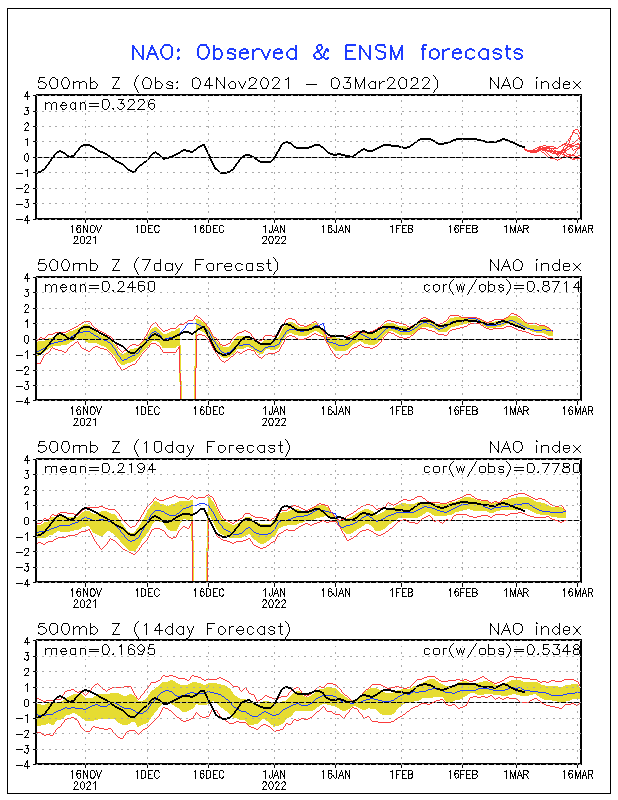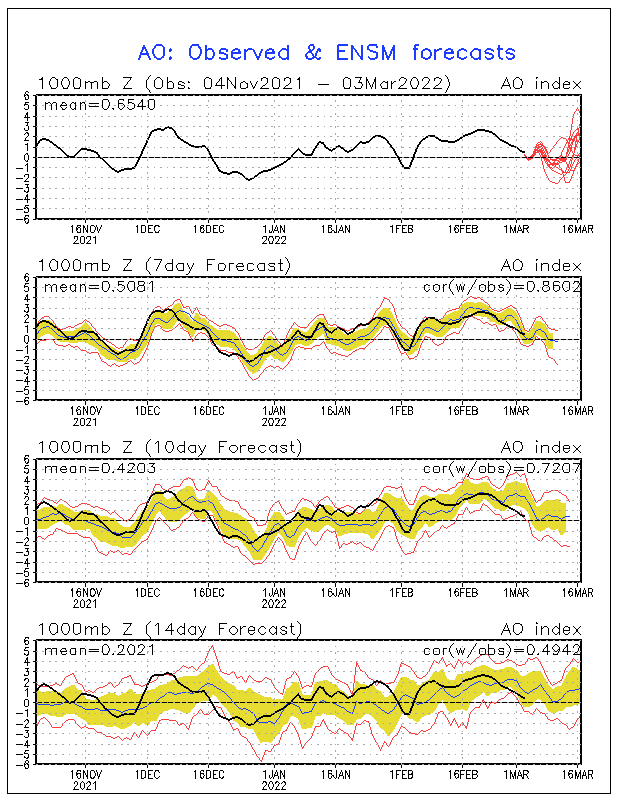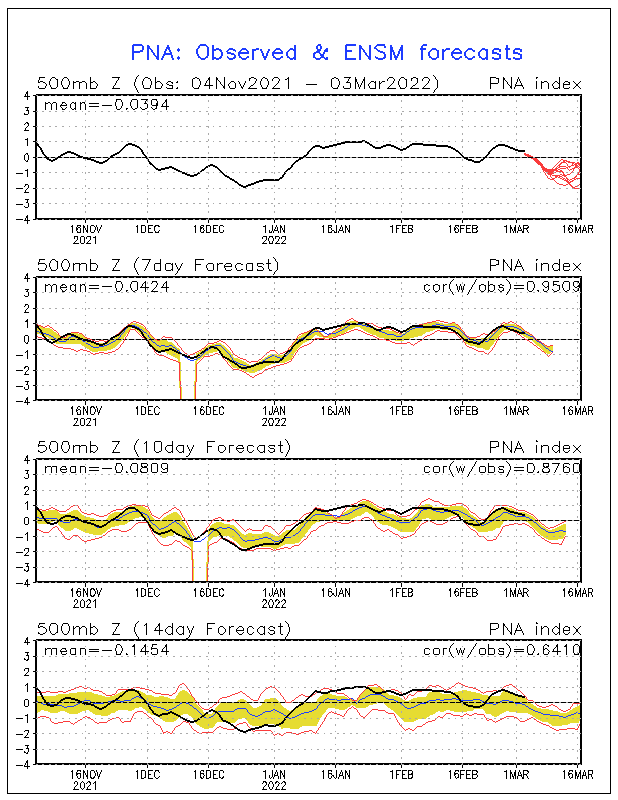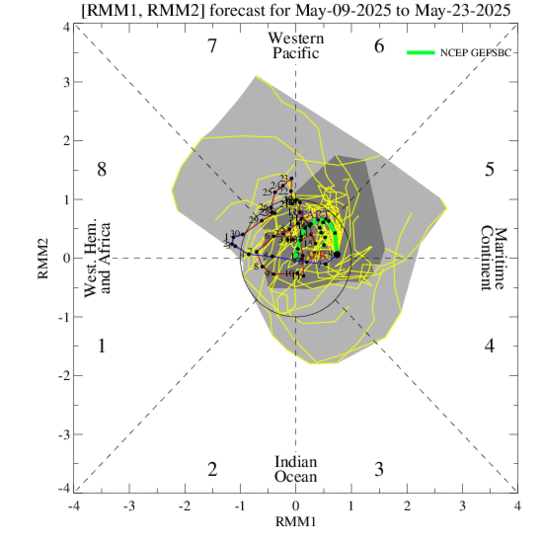An area of low pressure will be developing across the mid-Atlantic states during the day tomorrow and then drift north/northeastward passing just to the east of the Cape/Islands. Several computer forecast models are all developing an inverted trough or a "norlun" trough. Typically we see troughs form and develop in a more northerly to southerly type fashion, however, the trough associated with the area of low pressure will actually be oriented in a easterly to westerly fashion. This will allow for moisture associated with the area of low pressure to be thrown back westward into portions of central/southern New England.
These norlun trough setups are always highly intriguing and make forecasting precipitation, in this case, snowfall very difficult b/c in the end it all comes down to mesoscale features and more often than not we really can't pin down the mesoscale features until the hours leading up to the event or in some cases not until the event has already gotten underway! What we can, do however, is take a look at all the computer data available to us and sort of pinpoint an area of where these features may setup.
The most important mesoscale feature in this case will be with regards to where any heavier bands of snowfall setup. Given the model data we have it appears quite likely that any heavier bands of snowfall will setup out across far eastern MA and the Cape region with potentially another band of heavier snowfall across extreme northeastern MA extending into southwestern NH. At this stage we also can't rule out portions of RI and eastern or SE CT getting into the heavier banding as well, however, this would depend on when the heaviest banding begins setting up and how much moisture the trough can throw back.
Thanks to an Arctic front that has been pushing eastward through the region during the afternoon the airmass ahead of this system will be extremely cold from the surface all the way up through the troposphere. This will lead to some very impressive snowfall ratios, possibly in the order of 15:1 to 20:1 or perhaps even up near 25:1! Given the high ratios we would be seeing this means we really don't need a great deal of moisture of precipitation to produce moderate amounts of snowfall accumulation as the snow will have a very high fluff factor.
Given with what the computer models have been signaling the past 24-hours this is what I think we should see for snowfall across the region. Granted, we are still about 24-30 hours away from the onset of the system so we could still see major changes with regards to track/strength and how much moisture gets thrown back westward into the region. Also, once we get to tomorrow afternoon or early evening we should have a much better handle on the mesoscale features and where the heaviest band or bands will setup and we will be able to fine tune where the axis of heaviest snowfall will be.
Snowfall should start late Monday evening/early overnight and last through much of the AM hours on Tuesday, especially across eastern sections where light snows could last into the early afternoon hours. Snowfall rates of 2-3'' per hour are possible, even some isolated 4'' per hour rates. One interesting to watch out for will be the potential for thundersnow within the heaviest bands. Computer models are suggesting we could see some elevated instability work into eastern sections of the region. If we are able to generate thundersnow this would increase the potential for 4''/HR rates.
Sunday, January 20, 2013
Tuesday, January 15, 2013
Light/moderate snowfall event Wednesday, January 16th, 2013
A weak area of low pressure sliding south and east of southern New England is expected to bring snow/sleet/freezing rain/rain to all of southern New England beginning during the early pre-dawn hours Wednesday morning. What precipitation type or types your area receives will all determine where you are in relation to the system and we'll get into these details a little further down!
This storm system is not expected to be overly strong and produce significant snowfall amounts, however, given how the timing of the storm will be occurring during the AM rush hour this will make the morning communicate very difficult. Expect a great deal of school delay's/closings.
Precipitation is going to begin breaking out between the hours of 2-5 AM with extreme southwestern southern New England getting into the action first and extreme northeastern southern New England getting into the action last. It is also very possible that a few isolated pockets of precipitation occur across some locations even sooner than that. Initially, with the exception of the immediate coastlines of CT/RI/SE MA, precipitation will begin as all snow. Across the immediate coastline locations precipitation is expected to begin as a mix of rain/snow or perhaps even all rain. Any snowfall across these areas should transition over to all rain rather quickly and snowfall totals should be less than a dusting and this is mainly on the grassy surfaces. As we work through the early morning hours the rain/snow line should gradually begin working back towards the north and west as warmer air begins to work in both at the surface and in the lower levels of the troposphere. This will line work northwest through eastern MA/RI/CT during the AM hours. As this line works northwest we will begin to see many locations transition over to a period of sleet/freezing rain/rain and some places will eventually turn over to all rain as the system is winding down. Areas across western/central MA and extreme northwestern CT are expected to remain all snow though a brief mix of sleet can't be ruled out. One thing that we will have to watch out for will be a period of icing which will be possible if any locations can maintain a surface temperature in the lower 30's while temperatures aloft begin to warm. Freezing rain is not expected to be a major issue but we could see a glaze of icing or perhaps maybe even an accumulation of around 1/10th of an inch. This potential will be for the areas ending up right around the rain/snow line and will be highlighted with the map below. Precipitation will begin winding down mid to late afternoon.
The area encircled in red is where the best likelihood of freezing rain/glazing has a chance of occurring.
This storm system is not expected to be overly strong and produce significant snowfall amounts, however, given how the timing of the storm will be occurring during the AM rush hour this will make the morning communicate very difficult. Expect a great deal of school delay's/closings.
Precipitation is going to begin breaking out between the hours of 2-5 AM with extreme southwestern southern New England getting into the action first and extreme northeastern southern New England getting into the action last. It is also very possible that a few isolated pockets of precipitation occur across some locations even sooner than that. Initially, with the exception of the immediate coastlines of CT/RI/SE MA, precipitation will begin as all snow. Across the immediate coastline locations precipitation is expected to begin as a mix of rain/snow or perhaps even all rain. Any snowfall across these areas should transition over to all rain rather quickly and snowfall totals should be less than a dusting and this is mainly on the grassy surfaces. As we work through the early morning hours the rain/snow line should gradually begin working back towards the north and west as warmer air begins to work in both at the surface and in the lower levels of the troposphere. This will line work northwest through eastern MA/RI/CT during the AM hours. As this line works northwest we will begin to see many locations transition over to a period of sleet/freezing rain/rain and some places will eventually turn over to all rain as the system is winding down. Areas across western/central MA and extreme northwestern CT are expected to remain all snow though a brief mix of sleet can't be ruled out. One thing that we will have to watch out for will be a period of icing which will be possible if any locations can maintain a surface temperature in the lower 30's while temperatures aloft begin to warm. Freezing rain is not expected to be a major issue but we could see a glaze of icing or perhaps maybe even an accumulation of around 1/10th of an inch. This potential will be for the areas ending up right around the rain/snow line and will be highlighted with the map below. Precipitation will begin winding down mid to late afternoon.
The area encircled in red is where the best likelihood of freezing rain/glazing has a chance of occurring.
Light/moderate snowfall event, Wednesday, January 16th, 2013
A weak wave of low pressure will be sliding just to the southeast of southern New England during the early AM hours of Wednesday. As the wave of low pressure works close enough to the region we will see a period of precipitation with snow/sleet/freezing rain/rain all occurring across the region. While this system is not expected to become all that strong there will be a small window where precipitation does fall rather heavily and this could lead to some isolated higher snowfall amounts. Precipitation is expected to begin breaking out during the pre-dawn hours. With the exception of the CT/RI/SE MA coasts precipitation is expected to begin as all snow. As the morning hours go on and warming begins to occur both at the surface and through the lower levels of the atmosphere snowfall will gradually begin to transition to sleet/freezing rain/rain, especially across much of CT/RI and eastern MA. The timeframe for heaviest precipitation should be from about 8 AM to about 1-2 PM in the afternoon before the precipitation begins to gradually slow down.
Thursday, January 3, 2013
Record warmth possible late next week?
Severe medium range/long range computer models have been hinting that as we move towards and into next week not only will our temperatures warm-up but we could be looking at a fairly significant warm-up, although it's unclear as to exactly how long the warm-up will last. First we will take a look at the synoptic set-up being depicted by the models and then we will take a look at some global teleconnection forecasts and apply that to the forecasted synoptic pattern and figure out whether this all makes sense or not.
As we near the end of the weekend an area of high pressure will be developing across the southeastern United States and this will prompt a warm front to lift northward towards southern New England. Models indicate that the warm front will push through likely during the day on Tuesday. As the warm front inches closer to the region we will see a slow moderation of the temperatures and once the warm front passes temperatures will really escalate upwards.
At the same time a warm front will be lifting northward, out across the western United States a trough will be developing as a potent piece of shortwave energy digs into the desert southwest. As this piece of energy continue to strengthen and sharpen the developing trough, the response to this will be to build a ridge into the eastern United States and slowly expand northward. As this process occurs this will turn the wind direction from a more northerly direction (which we are seeing now) to a more south/southwesterly wind direction. This will allow for a unseasonably warm low-level airmass to work well northward into southern New England by mid/late week.
Now that we have looked at the overall synoptic setup which is forecasted by several medium/long range forecast models we will now take a look at a few global teleconnections and then apply them to the synoptic pattern.
First off, we will take a look at the North Atlantic Oscillation (NAO). During the winter months, the state of the NAO is one of the main players in determining how our weather will be. The NAO is broken down into three different phases; positive, neutral, and negative. The NAO is deemed positive when the Icelandic Low Pressure center is deeper than average and the Azores High Pressure center is also stronger than average. This increased pressure gradient allows for a stronger jet stream across North America. With the jet stream being stronger it's more difficult to generate deep troughs, therefore, the jet stream remains rather flat and further to the north, keeping the cold air bottled up in the Arctic or the other side of the globe and allowing for milder air to invade the United States. The NAO is deemed negative when both the Icelandic Low Pressure and Azores High Pressure centers are weaker than average. This leads to a decreased pressure gradient which weakens the jet stream allowing for greather potential of troughs to form which allow for colder air to be delivered into the United States. The NAO is considered neutral when there is no clear signal or the the phase is too weak to have a major influence on the overall weather pattern. Currently the NAO is slightly positive but the signal is weak so it's more in the neutral zone. This is expected to change as we move through this weekend and into next week as model ensemble consensus is for the NAO to continue heading into the positive territory and even become quite positive:
As we near the end of the weekend an area of high pressure will be developing across the southeastern United States and this will prompt a warm front to lift northward towards southern New England. Models indicate that the warm front will push through likely during the day on Tuesday. As the warm front inches closer to the region we will see a slow moderation of the temperatures and once the warm front passes temperatures will really escalate upwards.
At the same time a warm front will be lifting northward, out across the western United States a trough will be developing as a potent piece of shortwave energy digs into the desert southwest. As this piece of energy continue to strengthen and sharpen the developing trough, the response to this will be to build a ridge into the eastern United States and slowly expand northward. As this process occurs this will turn the wind direction from a more northerly direction (which we are seeing now) to a more south/southwesterly wind direction. This will allow for a unseasonably warm low-level airmass to work well northward into southern New England by mid/late week.
Now that we have looked at the overall synoptic setup which is forecasted by several medium/long range forecast models we will now take a look at a few global teleconnections and then apply them to the synoptic pattern.
First off, we will take a look at the North Atlantic Oscillation (NAO). During the winter months, the state of the NAO is one of the main players in determining how our weather will be. The NAO is broken down into three different phases; positive, neutral, and negative. The NAO is deemed positive when the Icelandic Low Pressure center is deeper than average and the Azores High Pressure center is also stronger than average. This increased pressure gradient allows for a stronger jet stream across North America. With the jet stream being stronger it's more difficult to generate deep troughs, therefore, the jet stream remains rather flat and further to the north, keeping the cold air bottled up in the Arctic or the other side of the globe and allowing for milder air to invade the United States. The NAO is deemed negative when both the Icelandic Low Pressure and Azores High Pressure centers are weaker than average. This leads to a decreased pressure gradient which weakens the jet stream allowing for greather potential of troughs to form which allow for colder air to be delivered into the United States. The NAO is considered neutral when there is no clear signal or the the phase is too weak to have a major influence on the overall weather pattern. Currently the NAO is slightly positive but the signal is weak so it's more in the neutral zone. This is expected to change as we move through this weekend and into next week as model ensemble consensus is for the NAO to continue heading into the positive territory and even become quite positive:
Secondly, we will take a look at the Arctic Oscillation (AO). The AO sort of works in conjunction with the NAO and both are closely related. Like the NAO, the AO is measured in three different phases; positive, negative, and neutral. The AO is considered to be negative when geopotential heights over the Arctic region are well below-average leading to a much stronger than normal Polar vortex. This leads to a stronger jet stream which inhibits colder Arctic Air from being transported further south into the United States. during the negative phase of the AO, the geopotential heights are higher than average across the Arctic region. This leads to a weaker than average Polar vortex which leads to a weaker jet stream allowing for colder air to be transported further south into the United States. When the signal is not clear or weak, the AO is considered neutral. Currently, the AO is more neutral, however, model ensembles forecasts are for the AO to quickly rise into positive territory and become quite positive, at least for a brief time:
Thirdly, we will take a look at the Pacific North American pattern (PNA). The PNA can actually play a significant role on the weather pattern across the United States, especially when the PNA signal is strong or when the NAO/AO signal is fairly weak. The PNA is also measured as either being positive, negative, or neutral. A positive PNA consists of above-average geopotential heights over the western United States (or a ridge) and below-average heights across the southeastern United States (or a trough). This leads to above-average temperatures across the western United States with below-average temperatures across the southeastern and eastern United States. During the negative PNA phase there are below-average heights across the western United States (or a trough) and above-average heights across the eastern/southeastern United States. This leads to below-average temperatures across the western United States and above-average temperatures across the eastern/southeastern United States. Currently, the PNA is quite positive, although computer ensemble forecasts indicate that the PNA will be quickly descending towards the negative phase by next week:
Finally, we will take a look at the progression of the Madden-Julian Oscillation (MJO) waves. The MJO is a fluctuation of atmospheric pressures across the equatorial Indian Ocean and western Pacific ocean. These MJO waves will traverse across the Pacific Ocean varying in different strengths and one major influence on the strength is the temperatures of the water they cross over. MJO waves traverse along the equator in either a cyclonic or anticyclonic circulation. During the cyclonic phase moisture is added to the MJO wave, enhancing convection/rainfall associated with the wave and during the anticyclonic phase the MJO wave suppress convection/rainfall associated with this wave. MJO activity can play major roles in regions affected by the monsoon in both India and in the southwestern United States. MJO waves can also greatly influence the weather pattern across the United States and temperatures. The journey of the MJO is broken down into 8 different phases with each phase depending on the location of the MJO. Between now and the 17th of January GFS ensemble forecasts have the MJO not only entering phases 4-6 but the potential for the MJO wave to be rather strong. In reading the diagram below, the closer the "lines" to the center of the graph, the weaker the MJO wave and less of an influence on the weather pattern. The further towards the borders of the chart, the stronger the wave. Below is the diagram:
Phases 4-6 of the MJO are typically associated with temperatures above-average across much of the central/eastern United States and with below-average temperatures across the western United States.
Now we place all of this together. When looking at the forecasted synoptic pattern by several medium-long range computer forecast models and looking at the projected trend in several key global teleconnections we can conclude that the upcoming period looks to not only be above-average across much of the eastern United States but the potential will exist for at least a few days with temperatures running well above-average. The height of the warmth may occur in the Thursday-Sunday timeframe before a strong Arctic front looks to slide eastward. It's possible we may be looking at record high temperatures for portions of the eastern United States and some locations could see temperatures running anywhere from +10F above-average to +2-F above-average.
Following this period, it does appear we will see a transition towards more average or even below-average temperatures but other than that the signals are not very clear as to how exactly the pattern will evolve.
Subscribe to:
Posts (Atom)






